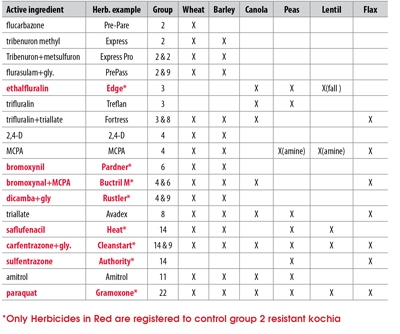
Features
Herbicides
Seed & Chemical
Getting the most from pre-seed weed control
With the confirmation of glyphosate-resistant kochia in southern Alberta, weed scientists are advising farmers to step back and re-assess their pre-seed weed control options. To help delay the onset of herbicide resistant weeds from developing, weed scientists are advising farmers to go beyond glyphosate-only applications and to apply products with unique or multiple modes of action.
“Look at what herbicides to apply or tank-mix together in a pre-seed application to better manage herbicide resistance,” explains Ken Sapsford, research associate at the University of Saskatchewan. “That is the short term solution, as weeds will adapt to selection pressure over time. In the long term, herbicide selection has to become a component of integrated weed management.”
Sapsford, and research scientist Eric Johnson with Agriculture and Agri-Food Canada at Scott pulled together a pre-seed herbicide application chart, excluding glyphosate, to help guide farmers on herbicide selection to manage glyphosate resistance. Glyphosate is still required in our direct seeding system, and by adding these other chemistries as a pre-seed application, we can extend the usefulness of glyphosate and reduce the development of future glyphosate resistant weeds
The chart also highlights the herbicides that control Group 2
resistant biotypes of kochia. With most kochia populations on the Prairies Group 2 resistant, these red-starred herbicides would be the choice for farmers wanting to control kochia with a pre-seed application while managing glyphosate resistance. Where kochia isn’t a weed of concern, the other products not highlighted are also valuable for glyphosate resistance management.
“If you don’t have Group 2 resistance issues, the Group 2 products are still a good option,” explains Sapsford.
Sapsford also says farmers should consider all registered pre-seed applications, including soil-applied products Edge and Treflan.
May 8, 2012 By Bruce Barker
 Herbicides that are Registered for Pre-seed applications With the confirmation of glyphosate-resistant kochia in southern Alberta
Herbicides that are Registered for Pre-seed applications With the confirmation of glyphosate-resistant kochia in southern Alberta